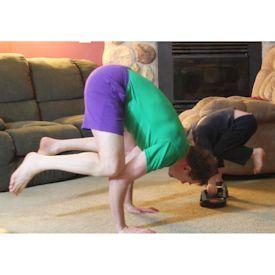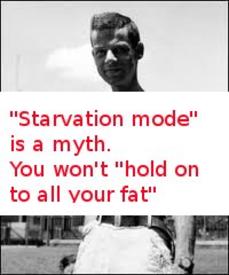To those of you who REALLY understand TDEE vs NEAT
Replies
-
For me the fitbit does all that. It adjusts my daily goal without me having to log anything (except for swimming.) I found it adjusts my daily TDEE with reasonable accuracy for bike rides, kayaking, kinect ping pong, and any of my other activities. I also wear it when lifting, where all the up and down and pacing and walking around during my workout produces a couple hundred extra calories there too. I just do my cardio when I feel like it and lifting because I want to gain strength, and eat the number the fitbit gives me in the MFP "food" tab.I understand them, but am kinda thinking out loud here and just want to make sure I'm not missing anything.
I'm not comfortable with TDEE - 15%, and I'm tired of logging exercise and constantly having to balance out cals. I also hate the whole exercise more to eat more mentality - I want to eat to control my weight and exercise to get faster, stronger, etc. As such, I'm considering taking a slightly different approach to all this calories nonsense.
...
Thoughts?0 -
tag, nice thread; thanks!0
-
For me the fitbit does all that. It adjusts my daily goal without me having to log anything (except for swimming.) I found it adjusts my daily TDEE with reasonable accuracy for bike rides, kayaking, kinect ping pong, and any of my other activities. I also wear it when lifting, where all the up and down and pacing and walking around during my workout produces a couple hundred extra calories there too. I just do my cardio when I feel like it and lifting because I want to gain strength, and eat the number the fitbit gives me in the MFP "food" tab.I understand them, but am kinda thinking out loud here and just want to make sure I'm not missing anything.
I'm not comfortable with TDEE - 15%, and I'm tired of logging exercise and constantly having to balance out cals. I also hate the whole exercise more to eat more mentality - I want to eat to control my weight and exercise to get faster, stronger, etc. As such, I'm considering taking a slightly different approach to all this calories nonsense.
...
Thoughts?
Same here. It requires a certain threshold of activity before I start "earning" more calories too. Only slightly more active and MFP is unchanged.0 -
tagging to read latter...0
-
Bumping to read later!0
-
For me the fitbit does all that. It adjusts my daily goal without me having to log anything (except for swimming.) I found it adjusts my daily TDEE with reasonable accuracy for bike rides, kayaking, kinect ping pong, and any of my other activities. I also wear it when lifting, where all the up and down and pacing and walking around during my workout produces a couple hundred extra calories there too. I just do my cardio when I feel like it and lifting because I want to gain strength, and eat the number the fitbit gives me in the MFP "food" tab.I understand them, but am kinda thinking out loud here and just want to make sure I'm not missing anything.
I'm not comfortable with TDEE - 15%, and I'm tired of logging exercise and constantly having to balance out cals. I also hate the whole exercise more to eat more mentality - I want to eat to control my weight and exercise to get faster, stronger, etc. As such, I'm considering taking a slightly different approach to all this calories nonsense.
...
Thoughts?
And that's fine, except that...
1) my fitbit is all over the board with workouts, so it's not a good estimate for me in that regard
2) I don't want a changing intake goal. I want 1 fixed calorie goal regardless of everything else.0 -
For me the fitbit does all that. It adjusts my daily goal without me having to log anything (except for swimming.) I found it adjusts my daily TDEE with reasonable accuracy for bike rides, kayaking, kinect ping pong, and any of my other activities. I also wear it when lifting, where all the up and down and pacing and walking around during my workout produces a couple hundred extra calories there too. I just do my cardio when I feel like it and lifting because I want to gain strength, and eat the number the fitbit gives me in the MFP "food" tab.I understand them, but am kinda thinking out loud here and just want to make sure I'm not missing anything.
I'm not comfortable with TDEE - 15%, and I'm tired of logging exercise and constantly having to balance out cals. I also hate the whole exercise more to eat more mentality - I want to eat to control my weight and exercise to get faster, stronger, etc. As such, I'm considering taking a slightly different approach to all this calories nonsense.
...
Thoughts?
Same here. It requires a certain threshold of activity before I start "earning" more calories too. Only slightly more active and MFP is unchanged.
I love my fitbit! Put it on, do my thing...see where is takes me!0 -
If your weight loss goal is set to 0 AND you eat back your exercise cals, then yes... you've been at maintenance.
If you change the weight loss goal, then MFP will adjust the number so you are in a deficit to reach that goal.
If you aren't eating back exercise cals, then you are in a deficit.
If you did both (changed the weight loss goal AND aren't eating back exercise cals), then you're in a big deficit.
cool0 -
Okay, so took the time to think about this post which is very good by the way.
When I lost most of my weight (before MFP), I used my HRM to see what I was burning through exercise. Still do when switching things up or just to make sure I am on target still. I use my body media to figure out what I am burning on a daily basis. Body media has me at about 2100 calories a day except for Tuesday which is golf day (walk and carry clubs 18 holes which all seem up hill) - goes up to over 3000. Usually do weight training and HIIT about 30-40 minutes 4 x week. Throw in some kayaking, biking, hiking maybe one of these 1x per week.
Calculated TDEE at both light active and moderately active and then averaged the number. Took 20% off of that and that's what I eat everyday no matter what except for Tuesdays because I would have a 1000 plus deficit. On Tuesdays I eat back so that I only have a 500 deficit.
I was thinking of lowering to take off 15% but I don't measure my food and I think my miscalculations on food portions more than make up that 5%.
I tend to eat the variety of things over and over again. This method makes things much easier because I don't really have to think about my calorie intakes anymore.0 -
My NEAT is ~2300. Workout cals on top of that can pretty much run the gammut - a couple hundred when lifting or HIITing to a couple thousand for serious cardio session. I'm thinking about setting my daily calorie goal to = NEAT and letting my exercise create the deficit. So a rest day would basically be eating at maintenance, exercise days would be in deficit.
Thoughts?
Being at a deficit on heavy workout days will tend to increase your LBM loss. Your body will not be able to build muscle since it will be in a caloric deficit, and the loss of LBM will be increased as your body struggles to find calories.
I would suggest that you eat at TDEE on heavy workout days, and at a deficit on your rest days. I think this will better help you preserve LBM while losing fat.
Anyone else believe this? This goes against most everything I've read regarding the role heavy lifting plays in LBM retention as well as the body's ability to shuttle cals based on need.
Nah.
It's true that heavy training is catabolic but this can be offset by a reasonably well put together diet. Detraining and muscular atrophy depends in part on your fitness level but you are looking at weeks rather than a day or two.
I suppose if you are looking at a concurrent recomp you could balance anabolic phases (ie maintenance / surplus) and catabolic phases (deficit) you could try the above but if you are looking at a straight cut (followed by a bulk if necessary) then it isn't worth worrying about.0 -
Ah, I see. My hunger tends to match my activity level pretty well so I really prefer to be able to eat a different amount every day, but I can see how just eating the same amount daily would be better for some people.
For me the fitbit does all that. It adjusts my daily goal without me having to log anything (except for swimming.) I found it adjusts my daily TDEE with reasonable accuracy for bike rides, kayaking, kinect ping pong, and any of my other activities. I also wear it when lifting, where all the up and down and pacing and walking around during my workout produces a couple hundred extra calories there too. I just do my cardio when I feel like it and lifting because I want to gain strength, and eat the number the fitbit gives me in the MFP "food" tab.I understand them, but am kinda thinking out loud here and just want to make sure I'm not missing anything.
I'm not comfortable with TDEE - 15%, and I'm tired of logging exercise and constantly having to balance out cals. I also hate the whole exercise more to eat more mentality - I want to eat to control my weight and exercise to get faster, stronger, etc. As such, I'm considering taking a slightly different approach to all this calories nonsense.
...
Thoughts?
And that's fine, except that...
1) my fitbit is all over the board with workouts, so it's not a good estimate for me in that regard
2) I don't want a changing intake goal. I want 1 fixed calorie goal regardless of everything else.
I would say use your reports to determine how many calories you've eaten in the last month or whatever, determine how much you're burning in a day (based on how much you've gained/lost) and average that amount, and eat that every day. Because if your routine is relatively stable over the course of the longer period (a month or two) then your heavier workout days will be included in your calculation.0 -
Whoops. I've been calling it that for a while. We need a name for TDEE - exercise then.
TDEEME
non-exercise TDEE. NETDEE.
oops, there's that NET again.0 -
I always just call it sedentary TDEE
Whoops. I've been calling it that for a while. We need a name for TDEE - exercise then.
TDEEME
non-exercise TDEE. NETDEE.
oops, there's that NET again.
Also, I'm really enjoying this thread 0
0 -
Bump, excellent thread!0
-
Bump...getting my nerd on...0
-
My NEAT is ~2300. Workout cals on top of that can pretty much run the gammut - a couple hundred when lifting or HIITing to a couple thousand for serious cardio session. I'm thinking about setting my daily calorie goal to = NEAT and letting my exercise create the deficit. So a rest day would basically be eating at maintenance, exercise days would be in deficit.
Thoughts?
Being at a deficit on heavy workout days will tend to increase your LBM loss. Your body will not be able to build muscle since it will be in a caloric deficit, and the loss of LBM will be increased as your body struggles to find calories.
I would suggest that you eat at TDEE on heavy workout days, and at a deficit on your rest days. I think this will better help you preserve LBM while losing fat.
Anyone else believe this? This goes against most everything I've read regarding the role heavy lifting plays in LBM retention as well as the body's ability to shuttle cals based on need.
I don't buy this either.
Unless you are at both a significant calorie and protein deficit - a heavy workout of a few hundred cals will not affect you except at very low bf% where protein availability as an energy source exceeds carbo. and lipid metabolism.
It also ignores the fact that caloric intake has differing digestion, absorption and utilization rates. What you eat one evening can easily be available as an energy source the following day. By far the most important aspect is to time the calories in a way to maximize training, so you may well end up eating more on lift days - but if you lift in the morning, you may well want to eat more the evening before.0 -
Bump0
-
Bumping0
-
bump for later0
-
Clear as mud.........Smile K xo0
-
We store glycogen and fat after eating a surplus amount of calories, but a 10 hour overnight fast sees off any post meal digestion doesn't it ? Hence all the fasted blood tests, RMR etc done in the morning after overnight fast.It also ignores the fact that caloric intake has differing digestion, absorption and utilization rates. What you eat one evening can easily be available as an energy source the following day. By far the most important aspect is to time the calories in a way to maximize training, so you may well end up eating more on lift days - but if you lift in the morning, you may well want to eat more the evening before.0 -
bump0
-
So... I've been doing this for the last few days, and so far I like it. But I realized something last night...
My original proposal was to set your daily calorie goal EQUAL to your BMR + TEF + NEAT (or, if you prefer, TDEE - exercise) and not log/eat back exercise. As you log food, you get closer and closer to you daily calorie goal and MFP's calories remaining number gets closer and closer to 0.
Pretty basic stuff right there.
One of the potential issues with this approach is very large deficits due to big cardio workouts.
But...
If you were to log exercise, then that calories remaining number would be your current deficit at any given time. As you log foods eaten, the calories remaining number decreases and your deficit gets smaller. As you log exercise it goes up and your deficit increases.
This makes it incredibly easy to manage your deficit. Most days you'll still be eating that same base number of cals (TDEE - exercise), do it's still a fixed intake approach. But it's very easy to see if your deficit is getting too high on any given day, at which point you could simply eat a bit more to make for a more reasonable deficit.
Yes, it means logging exercise, which I was hoping to get away from, but in some cases it might be worth the extra logging.0 -
OP - thanks for the recommendation to visit. Very informative stuff here! All the best!0
-
I know and understand my BMR and TDEE. How / where to you calculate NEAT. I workout every day and recently started wearing a pedometer to ensure my NEAT is good...just don't know what NEAT numbers are.0
-
So... I've been doing this for the last few days, and so far I like it. But I realized something last night...
My original proposal was to set your daily calorie goal EQUAL to your BMR + TEF + NEAT (or, if you prefer, TDEE - exercise) and not log/eat back exercise. As you log food, you get closer and closer to you daily calorie goal and MFP's calories remaining number gets closer and closer to 0.
Pretty basic stuff right there.
One of the potential issues with this approach is very large deficits due to big cardio workouts.
But...
If you were to log exercise, then that calories remaining number would be your current deficit at any given time. As you log foods eaten, the calories remaining number decreases and your deficit gets smaller. As you log exercise it goes up and your deficit increases.
This makes it incredibly easy to manage your deficit. Most days you'll still be eating that same base number of cals (TDEE - exercise), do it's still a fixed intake approach. But it's very easy to see if your deficit is getting too high on any given day, at which point you could simply eat a bit more to make for a more reasonable deficit.
Yes, it means logging exercise, which I was hoping to get away from, but in some cases it might be worth the extra logging.
Okay you have a math / statistics background!!! Please run my numbers and I will be forever indebted. 0
Please run my numbers and I will be forever indebted. 0 -
I know and understand my BMR and TDEE. How / where to you calculate NEAT. I workout every day and recently started wearing a pedometer to ensure my NEAT is good...just don't know what NEAT numbers are.
NEAT is basically what MFP estimates.
I know mine because I've been doing this long enough, with enough attention to detail and consistency, to know how many calories I need to maintain.0
This discussion has been closed.
Categories
- All Categories
- 1.4M Health, Wellness and Goals
- 398.2K Introduce Yourself
- 44.7K Getting Started
- 261K Health and Weight Loss
- 176.4K Food and Nutrition
- 47.7K Recipes
- 233K Fitness and Exercise
- 462 Sleep, Mindfulness and Overall Wellness
- 6.5K Goal: Maintaining Weight
- 8.7K Goal: Gaining Weight and Body Building
- 153.5K Motivation and Support
- 8.4K Challenges
- 1.4K Debate Club
- 96.5K Chit-Chat
- 2.6K Fun and Games
- 4.8K MyFitnessPal Information
- 12 News and Announcements
- 21 MyFitnessPal Academy
- 1.5K Feature Suggestions and Ideas
- 3.2K MyFitnessPal Tech Support Questions



















